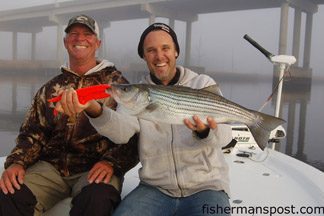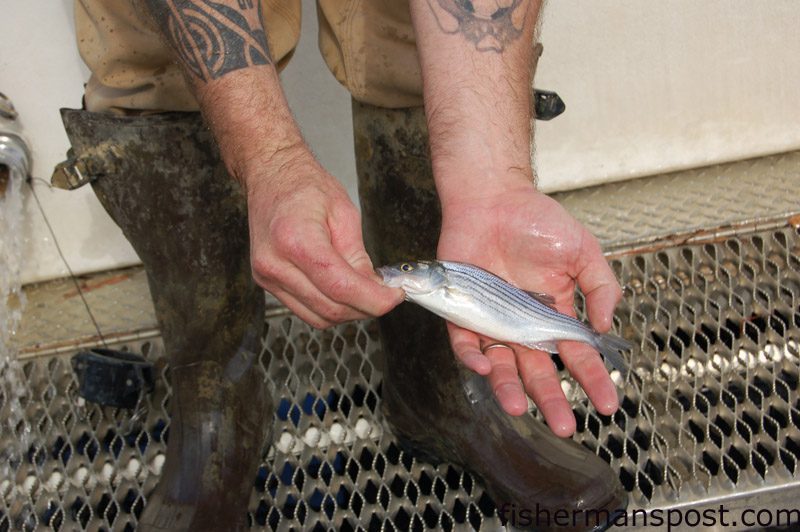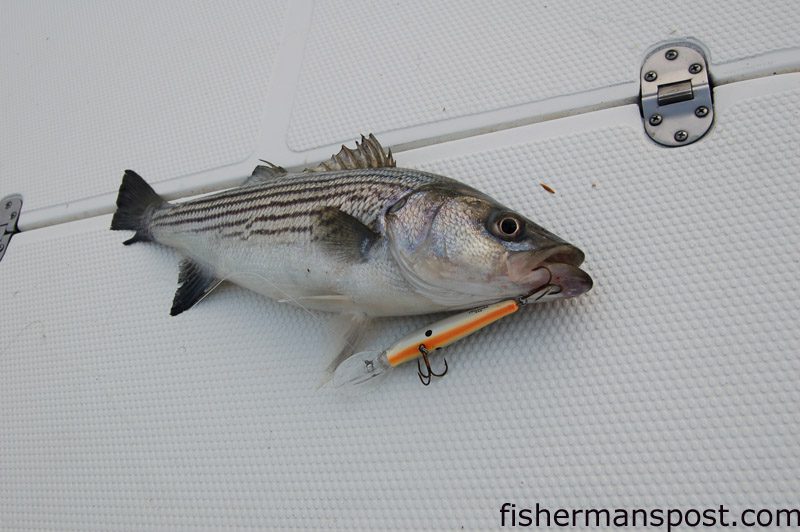Guide Time – Stripers: Pipe to Rock

Capt. Jeff Wolfe, of Seahawk Inshore Fishing Charters, and Gary Hurley beam at a healthy Cape Fear River striped bass that couldn’t turn down a Bomber Long A crankbait fished along a 10′ drop-off just north of downtown Wilmington.
A low fog shrouded the towers of the Cape Fear Memorial Bridge as Capt. Jeff Wolfe, of Seahawk Inshore Charters, eased his Kenner bay boat into the Cape Fear River early one December morning. Despite a forecast high near 70 for the day, the mist resisted the sun’s efforts to burn it off and warm the morning, and Jeff, Gary Hurley, and I were bundled up like ice fishermen as we idled out of the ramp and the captain eased the Kenner on plane. High hopes to catch and release some of the Cape Fear’s striped bass kept our blood flowing despite the chill, and the NC State Port’s cranes and container ships eerily loomed out of the fog as the bridge faded back into it.
“You guys grab these diving plugs,” Jeff instructed after easing the trolling motor into the water after the brief, but bracing ride. “There’s a ledge here we’re going to cast around.”
We eagerly complied, grabbing medium-light spinning outfits from the console holders and beginning to fan cast the area while Jeff eased the boat around the spot. The diving crankbaits kept our rod tips bouncing rhythmically as we retrieved them, but they went uninterrupted by the smashing strike of a striper, and Jeff gave it just a few minutes before deciding to pull the plug on the spot.
“It’s more of a first of falling tide spot,” he explained while we stowed our rods and prepared for another cool ride. “I just wanted to check it out real quick.”
The USS North Carolina and Wilmington waterfront were next to appear from the haze as we headed upriver and followed the curve of the Cape Fear River towards Brunswick County. Herons, egrets, ibises, and other waterbirds were also getting their fishing day underway, and the “Horseshoe Bend” that the Cape Fear takes before meeting up with the Brunswick River was choked with the black shapes of cormorants.
Like the birds, Jeff kept his eyes peeled for any sort of piscine activity along the timber-strewn banks as we motored along, but our next stop didn’t come until the Hwy. 17 Bridge over the Brunswick, a popular striper and trout spot.
“You guys keep casting those divers out towards the middle,” Jeff said after Power-Poling the Kenner in place near the muddy river banks, “and I’ll work this swimbait under the bridge.”
Our casts had met only resistance from the snag-riddled bottom after 10 minutes of fishing, and Jeff decided to continue fishing on the move.
The Cape Fear’s striped bass can be rather tricky to find and pattern, so the run and gun approach is a sound method to locate some feeding fish. While anglers occasionally release double-digit numbers of fish in a day’s time, it’s much more typical to spend the day on the move looking for a few bites.
The river once had a booming striped bass fishery, along with big runs of other migratory fish like sturgeon, shad, and river herring, but populations of many species have dropped by over 90% from historical levels. A myriad of factors have played a role, but by far the largest is the fish’s loss of access to their upriver spawning habitats, an unintended consequence of the lock and dam system on the Cape Fear. Three lock-and-dam structures dot the river between Fayetteville and Wilmington, and the fish have a very difficult time transiting them.
Fortunately, the Cape Fear striper population has a number of allies, and the future looks brighter than the present for stripers and other species that depend on the full watershed for their reproduction and life cycle.
The Cape Fear Riverwatch organization is a grassroots group based in Wilmington that focuses on maintaining and enhancing the river’s water quality and fisheries through advocacy, education, and action, and their efforts have secured the first victory in the battle to restore the waterway’s migratory fish populations.
Through a combination of fundraising and political maneuvering, the group laid the groundwork for a rock arch rapid at Lock and Dam #1, the closest of the three dams to Wilmington and the sea. Just completed, the structure is exactly what it sounds like, essentially a rock ramp extending downstream from the dam itself that allows fish to swim up and over the structure en route to their spawning grounds. The project started in 2010, and striped bass had already begun successfully negotiating the rapid before it was even complete.
“The Army Corps of Engineers literally put the last rock on two weeks ago,” explained Cape Fear Riverkeeper Kemp Burdette, “but five fish have already gone above Lock and Dam #1 this year. Two of them used the rock ramp when it was only about halfway complete.”
How does Riverwatch know fish traversed the dam? Because in addition to the rock ramp, they’ve spearheaded another project for the area’s migratory fish—implanting sonic tags in striped bass, sturgeon, and shad to monitor their movements through the river. A series of receivers along the river record each fish’s unique ping as they pass within range and either upload the data by satellite or when biologists download it in person.
One of the organization’s main fundraisers each year is Striperfest, a two-day event combining a banquet, auction, education day, and tag and release striped bass tournament.
Realizing that fish might be traversing the rapids already, Burdette and Riverwatch ponied up funds for 20 sonic tags for striped bass prior to the 2012 Striperfest, and many of the larger fish caught during the event underwent a minor surgical procedure to implant one of the sonic tags.
“When the anglers catch fish over 24 inches,” Burdette said, “they call a DMF boat over and the fish gets passed off. The striper receives a light anesthetic and the tags are surgically implanted in their bellies. It’s about a 30 minute process.”
Other fish caught during the event receive spaghetti tags and tiny microchips implanted in their cheeks that allow biologists to identify them with a code reader, the same technology gaining popularity to return lost pets to their owners.
Thanks to more funds generated from Striperfest, 20 more striped bass will receive tags in tandem with the 2013 event, scheduled for January 18-19 at the Coastline Convention Center.
“The batteries in the tags last 2-3 years,” Burdette continued. “At some point we’ll have to stop tagging them until some of the batteries die because once you reach a certain number of fish, it’s hard for the receivers to hear each one with all the noise.”
In addition to tagging more fish, Riverwatch is also fervently pursuing the construction of rock ramps at the other two lock and dam systems along the river to restore the Cape Fear’s migratory fish access to their complete spawning grounds for the first time in over 100 years.
Back on the boat, Jeff, Gary, and I had tried a handful of other spots along the banks of the Cape Fear and northeast Cape Fear Rivers without a strike, but the captain grew a bit more animated as we eased up to the Isabel Holmes Bridge.
“We’re marking fish,” he exclaimed, gesturing at some activity visible on the depthfinder about halfway down the water column. “Let’s keep throwing the diving plugs.”
We grabbed our rods again and resumed casting while Jeff eased us by the bridge pilings on the trolling motor. A dozen casts and 75 yards in, we remained strikeless, and Jeff brought us back to where he’d initially noticed the fish on the sounder.
Gary and I had each let a cast off parallel to the bridge and begun the retrieve when I watched his rod tip dip sharply. He responded with a yank of his own, but whatever was on the other end of the line didn’t offer much resistance at first.
“Gary’s got an old catfish,” Jeff said with a grin as the fish obediently came towards the boat.
The closer it got, however, the deeper the bend in the rod grew, and the mystery adversary started to look a little more interesting. As Gary tried to lift the fish up towards Jeff’s waiting landing net, it suddenly came to life, tearing a short burst of line off the reel and boiling the surface a yard too far away to have any hope of a net shot. All three of us saw the fish’s sliver-white flanks and some rather long black stripes as it broke the surface, and our excitement grew considerably.
“Striper! Nice striper!” came out of just about everyone’s mouths at the same time, and Jeff cautioned Gary not to put too much pressure on the fish for fear the lure’s trebles might lose purchase in its maw.
Seemingly more than determined to make up for the battle’s lackluster beginning, it was several minutes before the striper gave us another look, as it responded to Gary’s modest gains in line with bullish charges down and out toward the river channel.
After another surface boil just out of range, Gary was able to work the fish up a final time, and Jeff slid the net under the radiant fish.

NC Wildlife Resources Commission’s Matt Turpin cradles one of the young Cape Fear-stock striped bass raised at the Watha Fish Hatchery for release into the river.
After a quick and jubilant photo session, Jeff eased the fish back into the river and it faded into the tannic water with an angry flip of the tail.
In response to the declining populations of striped bass in the Cape Fear, they closed to harvest four years ago, and though they’re tasty, not many anglers have complaints about releasing the hard-fighting fish to ensure the future viability of the fishery.
Jeff quickly eased us back to the spot where Gary had hooked his fish after we watched it swim off and we began casting with renewed fervor, hoping we hadn’t encountered the only active fish in the area.
It didn’t take long to find we hadn’t as the next 10 minutes provided a brief flurry of action, with Gary and Jeff each releasing a smaller striper and my plug finding the mouth of a puppy drum, all within a 100 yard stretch of the initial hookup. A few missed strikes later, the action died off as abruptly as it had begun.
We cast to a few more likely-looking areas (one of the most difficult aspects of this fishery is choosing where to fish as virtually every foot of the river shoreline looks like prime habitat) without success, and soon a late-morning obligation for Gary had us heading back to the ramp.
As we pulled up, I was surprised to see a large and unusual truck with no trailer attached backed down one of the two lanes.
“I think that’s the stocking truck!” Jeff exclaimed excitedly, and indeed, the strange apparatus behind the cab was a series of tanks and pumps designed to transport and transfer live fish.
As we eased up to the ramp, I hailed the truck’s operator.
“You guys stocking stripers?” I queried, to a positive response from Matt Turpin of the NC Wildlife Resources Commission.
“I’ve got about 20-30 minutes before I can let them go,” Turpin explained, “but you’re welcome to take pictures.”
Interested in seeing the stocking in action, I heartily agreed, and Jeff and I poked back out, casting around a nearby ledge to kill some time until the fish were ready to release.
When we returned, Turpin opened some valves, and a steady stream of water and 4-6” long striped bass began pouring out of a blue pipe at the back of the truck.
“These are straight-run stripers from the Cape Fear River,” he explained over the din of fish pouring from truck to river. “We raise them at the Watha Fish Hatchery in Pender County.”
A little over 20 minutes after he began, Turpin had added 8,000 fish to the Cape Fear’s striper stock, and said more trucks were en route to offload 100,000 young stripers before week’s end.
While the Cape Fear River’s striped bass population may be at a fraction of historical levels, with allies like Cape Fear Riverwatch and the Wildlife Resources Commission, the best could be yet to come for the stripers and all migratory fish in the watershed.
“We’re big supporters of the stocking program,” Burdette said after I recounted our encounter with the fish truck. “We love that they’re using native brood stock from the Cape Fear. It helps to keep the population in the river healthy enough that when we get the rock passages built at all three dams, there will be fish to use those passages.”
Anyone interested seeing the river’s fisheries regain their former glory or just learning more about them should make their way to at least one of the events at this winter’s Striperfest.
More information about all of Cape Fear Riverwatch’s programs is available at their website, www.capefearriverwatch.org, and anglers can see video of the rock ramp and track the movements of the tagged stripers, sturgeon, and shad at their fisheries advocacy page, www.capefearriverwatch.org/advocacy/fish-restoration.
For those who want to get in on the action firsthand, give a striper charter with Seahawk Charters a thought. Capt. Jeff Wolfe can be reached at (910) 619-9580 or through his website, www.seahawkinshorefishingcharters.com.






